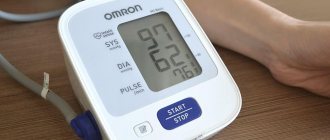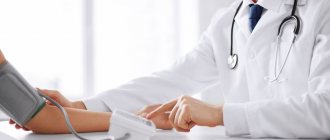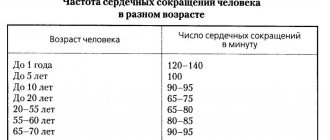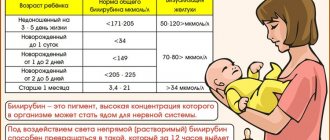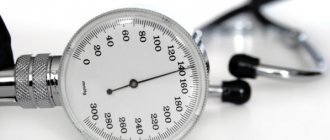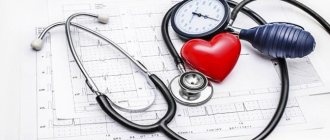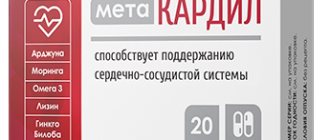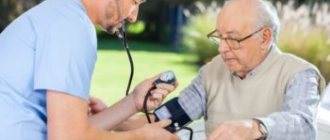Slow (weak) pulse is a condition in which the heart rate decreases to 60 beats per minute or below. The norm is considered to be 60-90 beats per minute. A pulse rate of less than 60 beats per minute is called bradycardia.
If the heart rate (HR) drops to 50 beats/min, this may indicate the presence of a disease. A constant, rare heartbeat at 40 beats/min for several days requires medical examination. A decrease in heart rate within 40-35 beats per minute poses a threat; the brain begins to feel a lack of oxygen; a decrease in heart rate to 30 beats per minute requires immediate medical attention.
Causes of a weak, slow pulse
Almost all reasons for a decrease in normal heart rate are associated with pathologies. Let's highlight the main ones:
- Cardiovascular – the cause of low pulse in a weak heart and associated diseases:
- syndrome of weak sinus node - the heart's own pacemaker, conduction disturbances (heart block), more often observed in the elderly;
- coronary heart disease, angina pectoris, heart failure;
myocardial infarction;
- cardiomyopathy;
- myocarditis;
- heart defects.
- Toxicology – poisoning by toxins of various origins:
- overdose of drugs (beta blockers, calcium antagonists);
acute food poisoning;
- diets – metabolic disorders;
- bad habits.
- Organic diseases – pathologies associated with the heart:
- diseases of the endocrine system (thyroid gland, diabetes mellitus, dysfunction of the adrenal glands);
increased sensitivity to stuffiness, heat;
- intracranial pressure;
- infectious diseases.
- Physiological bradycardia:
- night sleep - during sleep, all processes in the body slow down, including heart function and blood circulation.
professional sports - the pathology is called “athlete's heart syndrome”. In this case, the heart rate can drop below 50 beats per minute, without any negative consequences for the athlete. During exercise, your heart rate can increase quickly.
Help with hypotension and tachycardia in other cases
If the drop in blood pressure is not related to diabetes, an allergic reaction, or injury, the following measures should be taken:
- The person is laid on a flat surface.
- Place a pillow, folded blanket or other handy object under the shins so that the victim’s legs are elevated.
- In the room you need to open a vent or window for fresh air and turn on the air conditioner.
- If a person is wearing tight clothing, it should be removed or unbuttoned.
- For many people, a drop in pressure is accompanied by a decrease in body temperature, so the victim should be covered with a warm blanket.
- Strong sweet tea helps to quickly raise blood pressure during hypotension.
When providing assistance, you need to regularly measure blood pressure. If, despite the measures taken, a person becomes worse, it is necessary to call an ambulance or take the patient to a medical facility for examination and treatment.
Symptoms of a weak (slow) pulse
A 10% decrease in heart rate does not affect your well-being in any way. When the pulse reaches 40 beats/min, symptoms appear:
- weakness;
- dyspnea;
- darkening of the eyes;
- fainting state;
- fainting or loss of consciousness.
In the early stages, a decrease in heart rate may seem like a normal ailment or may be asymptomatic. Therefore, at the first symptoms, measure your blood pressure and pulse. If you notice a deviation from the norm, consult a doctor. At the cardiology center of the Federal Scientific and Clinical Center of the Federal Medical and Biological Agency, you will be offered several heart research programs and will conduct the necessary examinations to determine the cause of a weak pulse.
Drug therapy
The approach to treating bradycardia is complex; part of it is taking a number of medications. When choosing a drug, it is necessary to take into account the reason that caused the appearance of a low pulse. If the patient has hormonal imbalance, the doctor will prescribe appropriate medications to normalize it. Before this, the patient will be prescribed a blood test from a vein and, possibly, other instrumental studies to correctly diagnose the disorder.
In the presence of neurological causes, primarily autonomic dysfunction syndrome, complex therapy uses drugs that reduce the activity of the vagus nerve, for example Amizil, Bellataminal.
Treatment methods for sinus bradycardia
Medicines that have a stimulating effect on the body have proven themselves well. These drugs belong to the group of adaptogens of plant, animal, mineral and synthetic origin. Herbal remedies include tincture of eleutherococcus, lemongrass, ginseng and rhodiola, and Zelenin drops. They are used internally in pure form or diluted in boiled water at room temperature.
The biogenic stimulant Apilak should not be ignored. It contains royal jelly - a special secretion produced by the glands of bees to feed their offspring. This is a very valuable product, rich in vitamins, microelements, enzymes, nucleic and fatty acids, which makes it almost indispensable for doctors and patients when deciding how to raise their pulse.
Apilak
Another worthy representative of the group of adaptogens is Mumiyo. The drug is available in the form of tablets, paste and rectal suppositories. The active substance is collected on an array of high-mountain rocks, then the product undergoes purification processes and other technological processes that bring it into the form necessary for the medicine.
Mumiyo has a powerful restorative, restorative and tonic effect on the body. The specific effect is due to the complex of biologically active substances of both organic and inorganic nature included in the composition.
Adaptogens should be used in courses, in the first half of the day.
It is important to adhere to the prescribed dosages and not exceed them in order to avoid sleep disturbances, tachycardia, headaches, increased blood pressure and allergic reactions.
You should not expect instant results from some drugs, since most of them have a cumulative effect.
Diagnostics
Before making a diagnosis, it is necessary to undergo a series of studies that will confirm or refute the disease. Consultation with a cardiologist is necessary. The doctor begins by interviewing and examining the patient. After collecting anamnesis, the patient is sent for instrumental examination. Additionally, studies are prescribed:
- ECG;
- ECHO CG;
- MRI;
- chest x-ray;
- 24-hour Holter monitoring;
- load tests;
- consultation with a neurologist.
Timely diagnosis allows you to identify the disease, stop it and begin the necessary treatment.
Prevention
Prevention of a weak pulse involves eliminating the underlying disease that caused the bradycardia. It is necessary to undergo an annual examination and consult a doctor. Follow all his recommendations and assignments. Follow the dosage and regimen of taking medications. Lead a conscious lifestyle:
- eat right and watch your weight;
- engage in physical therapy;
- to refuse from bad habits.
For prevention purposes, never resort to traditional medicine without first consulting your doctor. Against the background of a weak pulse, high blood pressure may occur. And most recipes involve foods that can increase blood pressure. This will only harm your health and cause additional complications.
The most reliable method of prevention is regular examination. There are several programs at our center. You can get acquainted with them by following the link.
Diet
During therapy, it is recommended not only to carry out a therapeutic course, but also to eat properly. It is necessary to adhere to the following recommendations that will enhance the result of treatment:
- switching to fractional meals in small portions 5-6 times a day;
- Limiting the consumption of fried and fatty foods;
- Limiting the consumption of salty foods, which increase blood pressure;
- Avoid hard and carbonated drinks;
- limiting fluid intake to one and a half liters per day.
Before creating a diet, it is best to consult a nutritionist for help in choosing the healthiest foods.
How to treat
Before starting treatment, it is necessary to undergo a medical examination. Only after identifying the underlying cause can the attending physician prescribe therapy. The main methods include:
- drug therapy – taking medications. In our center, the Federal Scientific and Clinical Center for Medical and Biological Agency, patients are offered outpatient or inpatient treatment. If the patient is old, it is better to assign him to the therapeutic department, where he will be under the constant supervision of doctors and nurses. personnel;
- therapeutic and preventive procedures - moderate physical activity, adherence to a daily routine, taking herbal medicines as prescribed by a doctor for the purpose of prevention;
- surgical intervention - radical measures are resorted to when a concomitant disease affects the decrease in pulse rate. These include implantation of a pacemaker, elimination of certain rhythm disturbances that can lead to bradycardia. Only after all the necessary examinations and tests can the doctor recommend surgery. The cardiology center of the Federal Scientific and Clinical Center of the Federal Medical and Biological Agency has a surgical department. Doctors with many years of experience perform complex open-heart surgeries.
Slowly but surely: “long-term” methods
How to raise your heart rate for a long time? To make bradycardia attacks less frequent, you can use herbal treatment (herbal medicine) and regular physical activity. Taking medicinal herbs does not give a quick effect, but their gentle effect tones the cardiovascular system and the heart rate gradually increases.
If bradycardia is combined with low blood pressure, then the best option would be daily exercise. It can be supplemented with swimming, badminton, table tennis, and race walking. Even a regular walk can be a great workout for your heart if you alternate between fast and slow walking.
If bradycardia is caused by arrhythmia or other heart pathology, then a preliminary consultation with a cardiologist is required.
An excellent way to train the heart and blood vessels is hardening. At home, it is convenient to start with dousing your feet, and then move on to a contrast shower.
Phytotherapy
This method is used after an accurate diagnosis has been established. Treatment only with herbs can be used for neuroses and vegetative-vascular dystonia. In all other cases it is combined with drug treatment. The same decoction or infusion should be taken for about 2 months. Then the plant must be changed. Listed below are effective remedies that will help increase your heart rate.
- Infusion of yarrow. To prepare it, take 1 tablespoon of dry herb and add one glass of water. Place in a water bath and simmer for 15 minutes, covered, over low heat. Cool the infusion for 45 minutes, then strain. Drink a third of a glass 3 times a day before meals. Yarrow is contraindicated in cases of increased blood clotting.
- The infusion of tartar is prepared in the same way and used according to the same scheme. This plant not only raises the pulse, but also increases blood pressure. Therefore, it is better to use Tatarnik for bradycardia with hypotension. It is contraindicated in case of high blood pressure.
- Tincture of pine shoots. Only young shoots that appear in the spring at the tops of branches are used. 100 g of pine shoots should be poured with 300 g of vodka. Leave for 10 days in a bright place, avoiding direct sunlight. Take 10 drops mixed with a small amount of water 30 minutes before meals 3 times a day.
- Nettle tincture helps well with a slight decrease in heart rate. Pour 20 g of young shoots into 300 ml of vodka and leave for 20 days in a dark place. Take 20 drops at night, slightly diluted with water.
- Ginkgo biloba. This unique plant not only has a beneficial effect on the heart, but also improves cerebral circulation, restores memory, and increases mental abilities. For bradycardia, it can be used as follows: brew 1 teaspoon of crushed leaves with a glass of boiling water. You can add sugar or honey. It is enough to drink this drink once a day.
You can often find recommendations to use tinctures of adaptogen plants. These include lemongrass, ginseng, Rhodiola rosea, and Manchurian aralia. This recommendation is good only when bradycardia is combined with low blood pressure. Adaptogens increase the force of heart contractions, thereby helping to raise blood pressure and eliminate weakness and dizziness. But they do not increase the heart rate. Tinctures of these drugs should not be used if you have high blood pressure.
Folk remedies
Garlic, lemon and honey
Garlic is widely used in folk medicine. This is a powerful tool for strengthening the cardiovascular system. It normalizes vascular tone, strengthens capillaries, lowers cholesterol and blood sugar levels. Therefore, it is used for hypertension, diabetes, and atherosclerosis. It is also effective for bradycardia.
To prepare the medicinal mixture, take 5 lemons, 5 large heads of garlic, 0.5 liters of honey. Scald the lemons with boiling water, squeeze the juice out of them and mix it with chopped garlic and honey. Keep the container with the mixture in the refrigerator. Take 4 teaspoons half an hour before meals once a day. Keep each spoon in your mouth for at least a minute. The course of treatment is 1.5–2 months; after a break, taking the mixture can be continued. This remedy is contraindicated for gastric ulcers and inflammatory diseases of the gastrointestinal tract.
Walnut-lemon mixture
The nut-lemon mixture contains vitamin E and a lot of microelements. It is useful not only for bradycardia, but also has a beneficial effect on blood vessels and is good for brain function.
To prepare it, you need to take 4 lemons, 500 g of walnut kernels, a glass of sesame oil and honey. Cut the lemons into several pieces and pour boiling water for 20 minutes. Then remove them from boiling water and grind them together with the peel using a blender or meat grinder. The resulting mass must be mixed with chopped nuts, honey and sesame oil. Take the mixture 1 tablespoon 3 times a day half an hour before meals for 1 month. This remedy contains a lot of fat, so if you have liver and gallbladder diseases, you should take it with caution.
